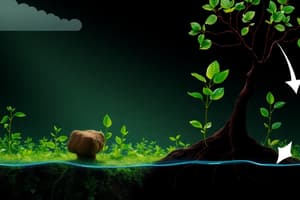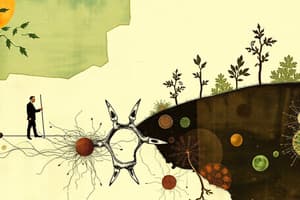Podcast
Questions and Answers
What do plants and other photosynthetic organisms primarily convert CO₂ into?
What do plants and other photosynthetic organisms primarily convert CO₂ into?
- Water and sugars
- Organic carbon compounds (correct)
- Methane and nitrogen
- Oxygen and carbon monoxide
Which process releases carbon back into the atmosphere as CO₂ during energy production?
Which process releases carbon back into the atmosphere as CO₂ during energy production?
- Carbon absorption
- Respiration (correct)
- Photosynthesis
- Decomposition
What is a significant byproduct released during the decomposition of organic matter?
What is a significant byproduct released during the decomposition of organic matter?
- Sulfur dioxide
- Ozone
- Carbon dioxide or methane (correct)
- Nitrogen gas
How do oceans interact with atmospheric CO₂?
How do oceans interact with atmospheric CO₂?
What is formed over millions of years from decayed organisms in the carbon cycle?
What is formed over millions of years from decayed organisms in the carbon cycle?
What human activity significantly disrupts the natural carbon cycle?
What human activity significantly disrupts the natural carbon cycle?
What form does carbon typically take when stored in soil?
What form does carbon typically take when stored in soil?
Which of the following is NOT a pathway for carbon to return to the atmosphere?
Which of the following is NOT a pathway for carbon to return to the atmosphere?
Flashcards
Photosynthesis
Photosynthesis
The process by which plants and other photosynthetic organisms convert atmospheric carbon dioxide (CO₂) into organic carbon compounds, storing it in their tissues.
Respiration
Respiration
The process by which plants and animals release carbon dioxide (CO₂) back into the atmosphere by breaking down organic matter for energy.
Decomposition
Decomposition
The breakdown of dead plants and animals by decomposers like bacteria and fungi, releasing carbon back into the soil and atmosphere.
Ocean Carbon Exchange
Ocean Carbon Exchange
Signup and view all the flashcards
Carbon in Fossil Fuels
Carbon in Fossil Fuels
Signup and view all the flashcards
Carbon in Soil
Carbon in Soil
Signup and view all the flashcards
Human Impact on the Carbon Cycle
Human Impact on the Carbon Cycle
Signup and view all the flashcards
Carbon Dioxide in the Atmosphere
Carbon Dioxide in the Atmosphere
Signup and view all the flashcards
Study Notes
Carbon Cycle Overview
- Carbon dioxide (CO₂) is a primary form of atmospheric carbon.
- Photosynthesis converts atmospheric CO₂ into organic compounds like sugars by plants, algae, and cyanobacteria.
- Carbon is stored in plant and animal tissues, moving through food chains.
- Respiration releases CO₂ from both plants and animals.
- Decomposers release carbon back into the soil and atmosphere as CO₂ or methane (CH₄).
- Oceans absorb significant amounts of atmospheric CO₂, supporting marine life's photosynthesis.
- Some ocean carbon is stored in deep ocean and marine sediments.
- Fossil fuels (coal, oil, natural gas) store carbon from decayed organisms over long periods.
- Burning fossil fuels releases stored carbon back into the atmosphere.
- Carbon is also stored in soil organic matter from plant roots, plant remains, and animal remains.
- Deforestation, agriculture, and industrial processes greatly influence the carbon cycle.
- Human activities, especially burning fossil fuels, significantly raise atmospheric CO₂ levels, affecting the climate.
Studying That Suits You
Use AI to generate personalized quizzes and flashcards to suit your learning preferences.




